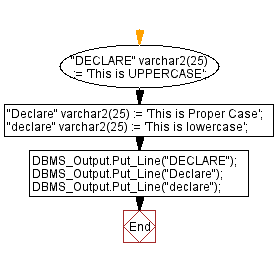PL/SQL Fundamentals Exercises: PL/SQL block to show Reserved Word as User-Define Identifier
PL/SQL Fundamentals: Exercise-3 with Solution
Write a PL/SQL block to show a reserved word can be used as a user-define identifier.
In the example below quoted user-defined identifiers "DECLARE", "Declare", and "declare" have been declared. The word DECLARE, Declare and declare represent the same reserved word, "DECLARE", "Declare", and "declare" represent different identifiers.
PL/SQL Code:
DECLARE
"DECLARE" varchar2(25) := 'This is UPPERCASE';
"Declare" varchar2(25) := 'This is Proper Case';
"declare" varchar2(25) := 'This is lowercase';
BEGIN
DBMS_Output.Put_Line("DECLARE");
DBMS_Output.Put_Line("Declare");
DBMS_Output.Put_Line("declare");
END;
/
Sample Output:
This is UPPERCASE This is Proper Case This is lowercase Statement processed. 0.16 seconds
Flowchart:

Improve this sample solution and post your code through Disqus
Previous: Write a PL/SQL block to show an invalid case-insensitive reference to a quoted and without quoted user-defined identifier.
Next: Write a PL/SQL block to show the result to neglect double quotation marks in reserved word identifier.
What is the difficulty level of this exercise?
- New Content published on w3resource:
- HTML-CSS Practical: Exercises, Practice, Solution
- Java Regular Expression: Exercises, Practice, Solution
- Scala Programming Exercises, Practice, Solution
- Python Itertools exercises
- Python Numpy exercises
- Python GeoPy Package exercises
- Python Pandas exercises
- Python nltk exercises
- Python BeautifulSoup exercises
- Form Template
- Composer - PHP Package Manager
- PHPUnit - PHP Testing
- Laravel - PHP Framework
- Angular - JavaScript Framework
- Vue - JavaScript Framework
- Jest - JavaScript Testing Framework
